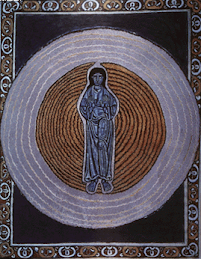For
fourteen years I have had a love affair with the worship space of St. Barnabas Episcopal Church, Glen Ellyn, IL where I have had the honor of serving as
rector. It is an unusually successful combination of contemporary and classic
design. Though that design is deliberately simple, there is an abundance of
symbolism “written” into the very structure. And there are other symbolic
features as well. Recently, I completed a brief booklet explaining some of
those feature. I’d like to share that here in a series of posts. Here is the
beginning:
“Reading” St.
Barnabas
What
does it mean to “read” a church? Historically, churches have been designed not
only for utility, but also for the edification of those who gather for worship.
The earliest churches had paintings on the walls. Eventually there were also
icons, stained glass windows, statues, banners, etc. But even the design and
structure of most churches have been intended to inform the faith and worship
of those who gather.
This is true of the worship space of St. Barnabas. Built in 1964, it was designed by architects Buderus & Sunshine. It received the top award “for excellence in religious architecture” given by the American Society for Church Architecture.
This is true of the worship space of St. Barnabas. Built in 1964, it was designed by architects Buderus & Sunshine. It received the top award “for excellence in religious architecture” given by the American Society for Church Architecture.
Our
worship space is rich with symbolism. What follows is an explanation of some of
that symbolism. Given the nature of symbolism, you will likely see other
meanings. If you see them, rejoice and be edified.
Red Doors
It
is customary, especially in Episcopal Churches, to paint the doors red. The
reason for this is obscure. There are several proposed explanations. The most mundane
is that once upon a time painting the doors of a building red signified that
the mortgage had been paid in full. Red doors also remind us of the Passover in
which God commanded the Hebrews to mark their doors with sacrificial lamb’s
blood to protect them from his judgment on the firstborn in the land of Egypt.
For Christians this symbolizes the blood of Jesus “poured out for many for the
forgiveness of sins” (Matthew 26:28).
Red
is liturgically significant. It represents the blood of the martyrs calling us
to lives of self-sacrificial love and discipleship and faithful witness (martus in Greek) to the good
news of Jesus Christ. Red also represents the fire of the Holy Spirit. When we enter
the church we place our lives in the sphere of the gift-giving Spirit who
births the church and us as its members, who comforts, strengthens, challenges,
refines, and transforms us. Red also reminds us that we are about to hear the
Scriptures, inspired by the Holy Spirit, read and proclaimed.
Jerusalem Cross
The
windows of the doors leading into our worship space are etched with the
Jerusalem Cross. This cross was first used as a coat of arms for the Latin
Kingdom in Jerusalem during the Crusades. These remind us that the Church and
its members have at times succumbed to the temptation of fear, power, and
violence in ways that are unfaithful to the glad tidings of peace promised at
the birth of the Prince of Peace. Thus, we are reminded that repentance is a
basic Christian practice and humility a basic Christian virtue.
Still,
the Jerusalem cross is a positive symbol: The larger central cross stands for
the person of Christ and the four smaller crosses are the four Gospels
proclaimed to the four corners of the earth, beginning in Jerusalem. Together,
they symbolize our focus on Christ and our commitment to proclaiming his good
news to the world. As we enter the worship space, they also remind us of the heavenly
Jerusalem that is our hope and the worship in that City in which our worship
participates.
"Reading" St. Barnabas II







No comments:
Post a Comment